
Orthoptera is an order of insects that comprises the grasshoppers, locusts, and crickets, including closely related insects, such as the bush crickets or katydids and wētā. The order is subdivided into two suborders: Caelifera – grasshoppers, locusts, and close relatives; and Ensifera – crickets and close relatives.

Pulmonata, or "pulmonates", is an informal group of snails and slugs characterized by the ability to breathe air, by virtue of having a pallial lung instead of a gill, or gills. The group includes many land and freshwater families, and several marine families.

Cucujiformia is an infraorder of polyphagan beetles, representing most plant-eating beetles. It includes species from the major superfamilies of Chrysomeloidea, Curculionoidea, Cucujoidea, and Tenebrionoidea.

Orthida is an extinct order of brachiopods which appeared during the Early Cambrian period and became very diverse by the Ordovician, living in shallow-shelf seas. Orthids are the oldest member of the subphylum Rhynchonelliformea, and is the order from which all other brachiopods of this group stem. Physically they are usually strophic, with well-developed interareas. They also commonly have radiating ribs, sulcus, and fold structures. Typically one valve, often the brachial valve, is flatter than the other. The interior structure of the brachial valves are usually simple. In shape they are sub-circular to elliptical, with typically biconvex valves.
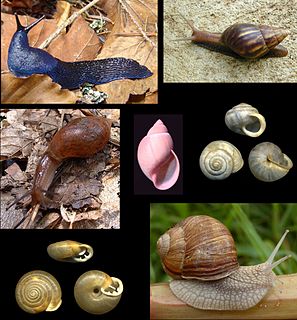
Sigmurethra is a taxonomic category of air-breathing land snails and slugs, terrestrial pulmonate gastropod molluscs. This is an informal group which includes most land snails and slugs.
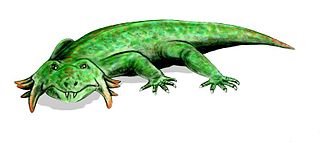
Procolophonoidea is an extinct superfamily of procolophonian parareptiles. Members were characteristically small, stocky, and lizard-like in appearance. Fossils have been found worldwide from many continents including Antarctica. The first members appeared during the Late Permian in the Karoo Basin of South Africa.
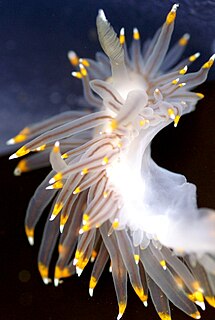
The Dexiarchia are a suborder of sea slugs, shell-less marine gastropod molluscs in the order Nudibranchia. This classification is based on the study by Schrödl et al., published in 2001, who recognized within this clade two clades Pseudoeuctenidiacea and Cladobranchia.
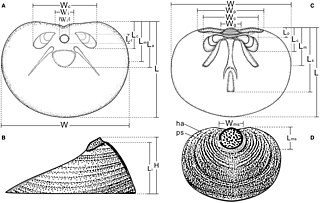
Acrotretida is an extinct order of linguliform brachiopods in the class Lingulata. They lived from the Lower Cambrian to the Middle Devonian. Acrotretida contains the sole superfamily Acrotretoidea. Many acrotretides have a tall and conical ventral valve with a pedicle opening at the apex, while the musculature is simplified relative to other linguliforms. The shell has a rounded outline, and is usually phosphatic like other linguliforms.

Paterinata is an extinct class of linguliform brachiopods which lived from the Lower Cambrian (Tommotian) to Upper Ordovician (Ashgill). It contains the single order Paterinida and the subfamily Paterinoidea.
A protein superfamily is the largest grouping (clade) of proteins for which common ancestry can be inferred. Usually this common ancestry is inferred from structural alignment and mechanistic similarity, even if no sequence similarity is evident. Sequence homology can then be deduced even if not apparent. Superfamilies typically contain several protein families which show sequence similarity within each family. The term protein clan is commonly used for protease and glycosyl hydrolases superfamilies based on the MEROPS and CAZy classification systems.
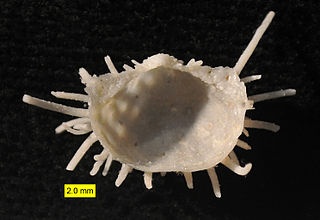
Productida is an extinct order of brachiopods in the extinct class Strophomenata. Members of Productida first appeared during the Silurian. They represented the most abundant group of brachiopods during the Permian period, accounting for 45-70% of all species. The vast majority of species went extinct during the Permian-Triassic extinction event, though a handful survived into the Early Triassic. Many productids are covered in hollow tubular spines, which are characteristic of the group. A number of functions for the spines have been proposed, including as a defensive mechanism against predators.
Orthotetida is an order of brachiopods containing the families:
An order of brachiopods containing the families:
Enteletoidea is an extinct superfamily of brachiopods in the order Orthida, containing:
A superfamily of brachiopods containing:
Orthoidea is a superfamily of brachiopods containing the families:
A superfamily of brachiopods containing:
A suborder of brachiopods containing the families:
Productidina is a suborder of brachiopods containing the families:
Strophalosiidina is a suborder of Brachiopod containing the families:









